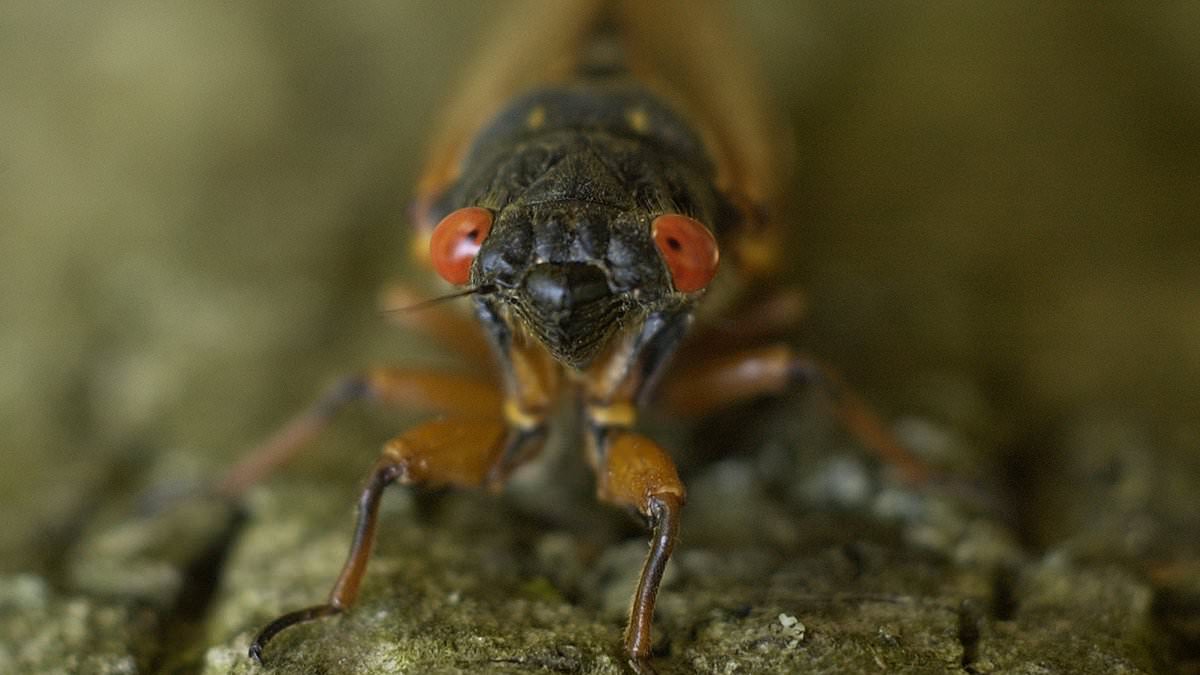An ‘annoying’ alien-like insect is set to emerge from a 17-year slumber and wreak havoc across multiple US states this year, scientists have warned.
Billions of ‘Brood XIV’ cicadas are currently tunneling out of their underground homes ready to swarm across 13 states by the spring.
The creepy red-eyed insects are set to emerge in New York, Georgia, Kentucky, Indiana, Massachusetts, Maryland, North Carolina, New Jersey, Ohio, Pennsylvania, Tennessee, Virginia and West Virginia this year.
The timing of their emergence can be unpredictable, but typically the bugs start to crawl out when the ground warms to 64F – usually between April and June for most areas.
Male cicadas cause chaos by making a high-pitched buzzing noise designed to attract females which is as loud as a lawn mower.
Last year, the bugs were so noisy that Americans called the cops to complain. Newberry County Sheriff’s Office in South Carolina received so many calls they issued a statement to reassure residents about the creatures.
‘We have had several calls about a noise in the air that sounds like a siren, or a whine, or a roar,’ the sheriff’s office wrote in April.
‘The sound is cicadas. Cicadas are a super family of insects that appear each spring. The nymphs have lived underground for 13-17 years and now this time they are hatching.

A huge alien-like insect is set to emerge from a 17-year slumber and wreak havoc across multiple US states this year, scientists have warned. (Pictured: the Brood XIV Cicada)

Billions of ‘Brood XIV’ cicadas are currently tunneling out of their underground homes ready to swarm across 13 states across eastern and central America
‘Although to some, the noise is annoying, they pose no danger to humans or pets. Unfortunately it is the sounds of nature.’
When they finally emerge after spending more than a decade underground sipping on tree root juices, the periodic cicadas do bring ecological benefits.
‘Cicadas are a valuable food source for birds and other predators,’ the US EPA noted, adding that the burrows dug by young ‘nymphs’ to feed on sap ‘aerate lawns and improve water filtration to the ground’.
Periodical cicadas have black bodies with red eyes and they arrive in droves, unlike annual cicadas which are greenish-brown and emerge in smaller numbers each year.
Broods of periodical cicadas only emerge every 13 or 17 years. This year’s invasion, Brood XIV or Brood 14, is the second-largest periodical cicada type at around two inches long, according to the University of Connecticut.
Once they emerge, cicadas are active for between four to six weeks before they vanish just as quickly as they came. Despite their noisy nature, they’re relatively tame.
‘All they do is just climb up on trees and pee. That’s as much damage as they do,’ Saad Bhamla, a professor at Georgia Tech College of Engineering told The Hill.
Even their pee is innocuous – unlike mammal urine, is almost entirely just water. ‘You don’t have to worry, it isn’t like our human pee. It isn’t disgusting, it’s just water,’ Bhamla said.

A huge alien-like insect is set to emerge from a 17-year slumber and wreak havoc across multiple US states this year, scientists have warned. (Pictured: the Brood XIV Cicada)

When they finally emerge after spending more than a decade underground sipping on tree root juices, the periodic cicadas do bring ecological benefits

One thing which makes the cicada so interesting is its ability to harden their exoskeletons – which takes about five days – shedding its old exterior in order to begin flying
This year’s invasion won’t be as bad as last year, when a one trillion of the red-eyed bugs infested the nation in a 200-year event known as the cicada ‘apocalypse’.
For the first time since the 19th century, two different broods of cicada emerged across more than a dozen states, mating and laying millions more eggs.
Dr Gene Kritsky, a professor, entomologist and cicada expert at Mount St. Joseph University, told DailyMail.com at the time: ‘The dual emergence is a one in two or three lifetime event.
‘This happens 12 times every 221 years, but this is the first time since 1803 that these broods will emerge together.’
There are more than 3,000 known species of cicadas, and they form 15 major ‘broods’ in different geographic areas.
What makes these creatures so interesting is the ability to harden their exoskeletons, which takes about five days, and shed it in order to being flying.
